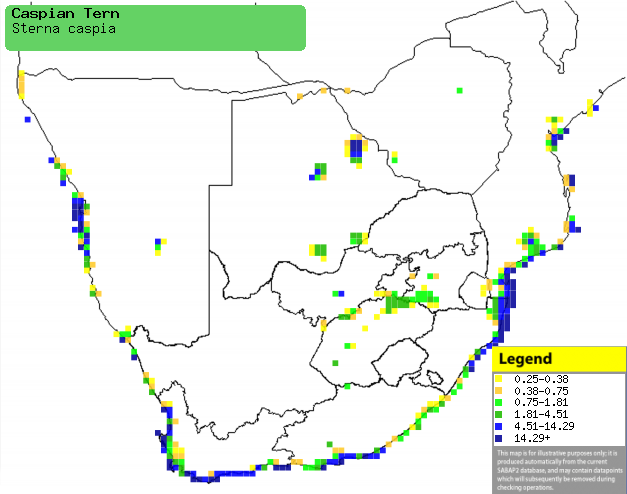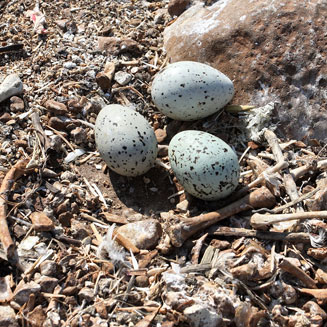|
Sterna caspia (Caspian
tern)
[= Hydroprogne caspia]
Reusesterretjie [Afrikaans]; Reuzenstern [Dutch]; Sterne
caspienne [French]; Raubseeschwalbe [German]; Gaivina-de-bico-vermelho
[Portuguese]
Life
> Eukaryotes >
Opisthokonta
> Metazoa (animals) >
Bilateria >
Deuterostomia > Chordata >
Craniata > Vertebrata (vertebrates) > Gnathostomata (jawed
vertebrates) > Teleostomi (teleost fish) > Osteichthyes (bony fish) > Class:
Sarcopterygii (lobe-finned
fish) > Stegocephalia (terrestrial
vertebrates) > Tetrapoda
(four-legged vertebrates) > Reptiliomorpha > Amniota >
Reptilia (reptiles) >
Romeriida > Diapsida > Archosauromorpha > Archosauria >
Dinosauria
(dinosaurs) > Saurischia > Theropoda (bipedal predatory dinosaurs) >
Coelurosauria > Maniraptora > Aves
(birds) > Order: Charadriiformes
> Family: Laridae > Genus: Sterna
Distribution and habitat
Occurs across much of the world, excluding South America
and Antarctica. Within southern Africa it is locally common along the coast of
the region as well as inland in Botswana and east-central South
Africa. It generally prefers sheltered bays, estuaries and large inland water
bodies, especially dams and saline pans.
|
 |
|
Distribution of Caspian tern in southern Africa,
based on statistical smoothing of the records from first SA Bird Atlas
Project (©
Animal Demography unit, University of
Cape Town; smoothing by Birgit Erni and Francesca Little). Colours range
from dark blue (most common) through to yellow (least common).
See here for the latest distribution
from the SABAP2. |
Predators and parasites
- Predators of eggs and chicks
Movements and migrations
Likely to be resident, however its movements
are not well understood.
Food
It mainly eats fish, doing most of its foraging 3-20 metres
above clear, shallow water, facing downwards so that it can spot fish. Once prey
is spotted it momentarily hovers before diving head-first into the water. The following food items have been recorded
in its diet:
- Fish
- Acanthopagrus berda (Riverbream)
- Johnius belengerii (Small kob)
- Clarias gariepinus (Sharptooth catfish)
- Pomadasys commersonnii (Spotted grunter)
- Oreochromis mossambicus (Mozambique tilapia)
- Thryssa vitrirostris (Orangemouth glassnose)
- Liza richardsonii (Southern mullet)
- soles (Soleidae)
- breams (Cichlidae)
Breeding
- Hardly studied in southern Africa, so most of the following information
comes from Europe. It is a monogamous, solitary or colonial nester,
maintaining a pair bond year-round.
- The nest (see image below) is excavated by both adults, consisting of a
shallow scrape in sand, gravel, soil or pebbles, often lined with some dry
vegetation.
 |
|
|
Caspian tern nest with eggs, Grootdraai Dam,
Mpumalanga, South Africa. [photo
Johan van
Rensburg ©] |
|
- Egg-laying season is from December-April in Namibia and Botswana,
June-August in north-eastern South Africa, February-July in KwaZulu-Natal
and the Eastern Cape and from October-January in the Western
Cape.
- It lays 1-3 eggs, which are incubated by both sexes for about 22-24
days.
- The chicks are brooded and fed by both parents, leaving the nest after
about a week, taking their first flight at approximately 30-35 days old but
only becoming independent about eight months later.
Threats
Near-threatened in South Africa.
References
-
Hockey PAR, Dean WRJ and Ryan PG 2005. Roberts
- Birds of southern Africa, VIIth ed. The Trustees of the John Voelcker
Bird Book Fund, Cape Town.
|
